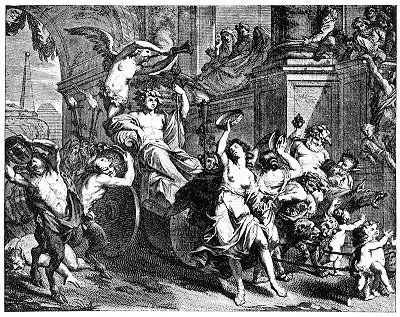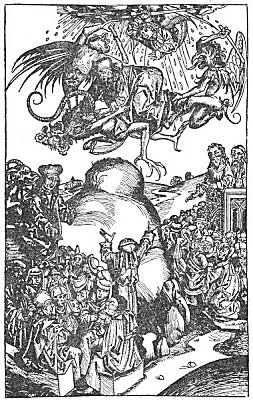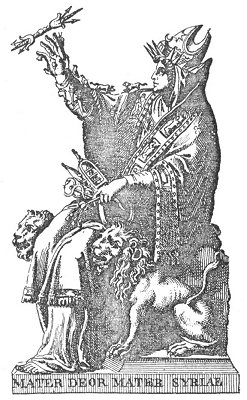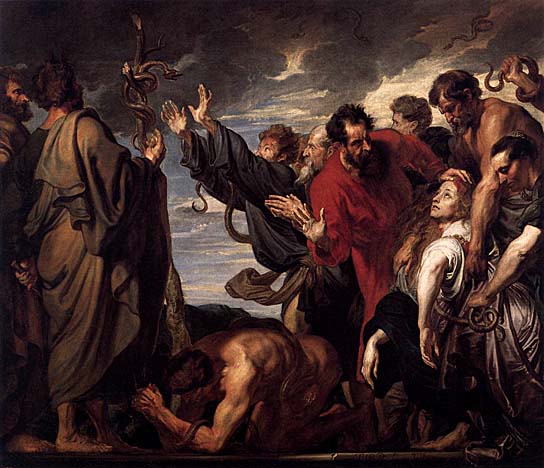p. 31
THE PROCESSIONAL OF THE BACCHIC RITES.
From Ovid’s Metamorphosis. In the initiation, of the Bacchic Mysteries, the rôle of Bacchus is played by the candidate who, set upon by priests in the guise of the Titans, is slain and finally restored to life amidst great rejoicing. The Bacchic Mysteries were given every three years, and like the Eleusinian Mysteries, were divided into two degrees. The initiates were crowned with myrtle and ivy, plants which were sacred to Bacchus.
In the Anacalypsis, Godfrey Higgins conclusively establishes Bacchus (Dionysos) as one of the early pagan forms of the Christos myth, “The birthplace of Bacchus, called Sabazius or Sabaoth, was claimed by several places in Greece; but on Mount Zelmisus, in Thrace, his worship seems to have been chiefly celebrated. He was born of a virgin on the 25th of December; he performed great miracles for the good of mankind; particularly one in which he changed water into wine; he rode in a triumphal procession on an ass; he was put to death by the Titans, and rose again from the dead on the 25th of March: he was always called the Saviour. In his mysteries, he was shown to the people, as an infant is by the Christians at this day, on Christmas Day morning in Rome.”
While Apollo most generally represents the sun, Bacchus is also a form of solar energy, for his resurrection was accomplished with the assistance of Apollo. The resurrection of Bacchus signifies merely the extraction or disentanglement of the various Parts of the Bacchic constitution from the Titanic constitution of the world. This is symbolized by the smoke or soot rising from the burned bodies of the Titans. The soul is symbolized by smoke because it is extracted by the fire of the Mysteries. Smoke signifies the ascension of the soul, far evolution is the process of the soul rising, like smoke, from the divinely consumed material mass. At me time the Bacchic Rites were of a high order, but later they became much degraded . The Bacchanalia, or orgies of Bacchus, are famous in literature.
p. 32
passed through two gates. The first led downward into the lower worlds and symbolized his birth into ignorance. The second led upward into a room brilliantly lighted by unseen lamps, in which was the statue of Ceres and which symbolized the upper world, or the abode of Light and Truth. Strabo states that the great temple of Eleusis would hold between twenty and thirty thousand people. The caves dedicated by Zarathustra also had these two doors, symbolizing the avenues of birth and death.
The following paragraph from Porphyry gives a fairly adequate conception of Eleusinian symbolism: “God being a luminous principle, residing in the midst of the most subtile fire, he remains for ever invisible to the eyes of those who do not elevate themselves above material life: on this account, the sight of transparent bodies, such as crystal, Parian marble, and even ivory, recalls the idea of divine light; as the sight of gold excites an idea of its purity, for gold cannot he sullied. Some have thought by a black stone was signified the invisibility of the divine essence. To express supreme reason, the Divinity was represented under the human form–and beautiful, for God is the source of beauty; of different ages, and in various attitudes, sitting or upright; of one or the other sex, as a virgin or a young man, a husband or a bride, that all the shades and gradations might be marked. Every thing luminous was subsequently attributed to the gods; the sphere, and all that is spherical, to the universe, to the sun and the moon–sometimes to Fortune and to Hope. The circle, and all circular figures, to eternity–to the celestial movements; to the circles and zones of the heavens. The section of circles, to the phases of the moon; and pyramids and obelisks, to the igneous principle, and through that to the gods of Heaven. A cone expresses the sun, a cylinder the earth; the phallus and triangle (a symbol of the matrix) designate generation.” (From Essay on the Mysteries of Eleusis by M. Ouvaroff.)

Moe is the founder of GnosticWarrior.com. He is a father, husband, author, martial arts black belt, and an expert in Gnosticism, the occult, and esotericism.






